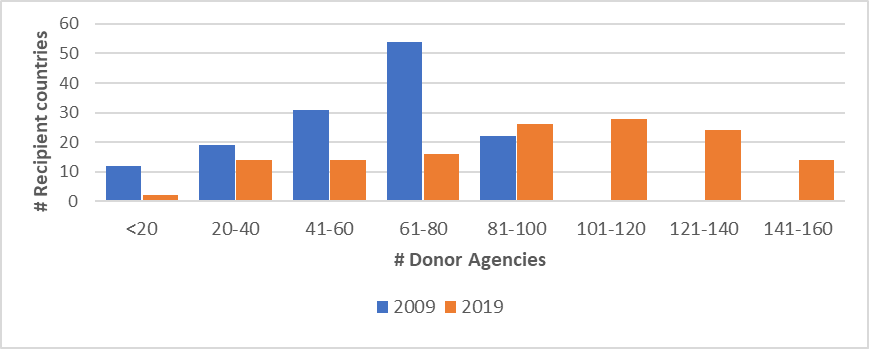 x
x
In the wake of the multiple overlapping crises the world is grappling with today, we have seen billions of dollars channeled by donors to recipients. The race to address these crises and their impacts is fueled by the desire to ensure the world stays on course to achieve the global development goals. Official financing for development is a big part of this story. Understanding the dynamics of development finance before the Covid-19 pandemic will play an important role in informing decision-making for better aid effectiveness going forward.
In our recent aid architecture landscape paper, the analysis showed, among other things, that development activities continue to remain highly fragmented. Building on these findings, we did further analysis in a paper titled Understanding Trends in Proliferation and Fragmentation for Aid Effectiveness During Crises. The analysis goes deeper into the increasing proliferation of official finance providers and implementing entities, and the continued fragmentation of donor-funded development activities during the 2000-2019 period.
Here are our main findings:
The increase in Official Financial Flows (OFF) was accompanied by increased proliferation in donors and donor funding entities. The good news was that OFF commitments increased by 187 percent in real terms over the last 20 years, reflecting the global development community’s financial support for the achievement of the Sustainable Development Goals. However, this increase in commitments was accompanied by a 50 percent increase in the number of countries and multilateral institutions providing official finance around the world, and an explosive 162 percent growth in the number of entities that provided official finance.
Source proliferation has accelerated at recipient country level over the last decade as evidenced by the growing share of countries dealing with more than 60 donor entities. The increase in donor agencies (i.e., source proliferation) at a global level is also mirrored in recipient countries. The number of countries with more than 60 donor entities increased from 55 percent in 2009 to 78 percent in 2019.
Proliferation of donor entities in recipient countries (2009 vs 2019)

Three out of every four OFF transactions were implemented by entities other than the recipient governments, posing an aid coordination challenge for partner/recipient governments. The increasing number of implementing entities cannot be measured fully based on available data. However recipient governments played a limited role, implementing only one out of every four OFF transactions, and less than one out of every two dollars’ worth of commitments in 2019. With more than half (55 percent) of transactions implemented by NGOs, donor government entities, and multilateral institutions, aid coordination remained a challenge.
The average size of a transaction has been decreasing slowly over the first decade from $2.2 million in 2000 and has stabilized at $1.4 million since 2009. There was an all-time high number of transactions in 2019, about 220,000. Official development assistance (ODA) grants dominated with 86 percent of the transactions, with an average value of $0.8 million in 2019.
For funding provided to recipient governments, pooled funding is a recognized solution to reduce the impact of aid fragmentation, but uptake has been low. During 2012–19, pooled funding through government budgets and donor funds, and core contributions to multilateral and other institutions accounted for only about 17 percent of OFF, despite global agreements to increase such funding. More than 70 percent of OFF continues to be implemented through project-type interventions.
What next?
These findings have sparked a further interest to explore country level impacts of proliferation on aid effectiveness. The next step will therefore be country case studies to provide a granular understanding, which would also enable a closer review of pooled funding approaches.
The increasing fragmentation and proliferation of aid does not help developing countries, which need to deal with multiple, overlapping crises efficiently to address the dire needs of their citizens in a timely manner. It would be important for the international community to arrest - and eventually reverse - these trends.
RELATED LINKS:



Join the Conversation